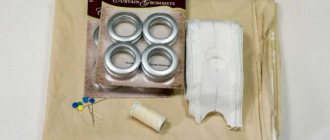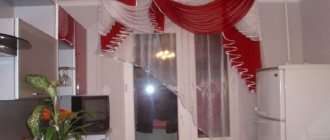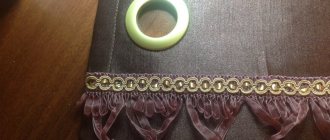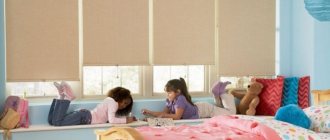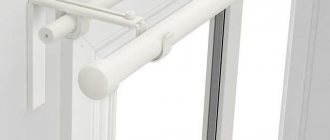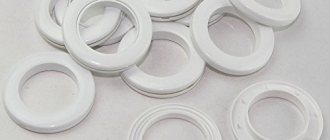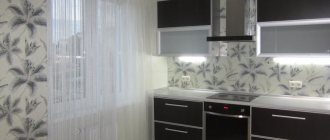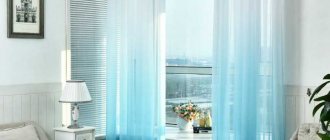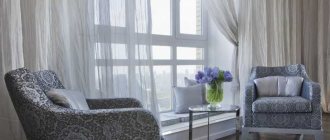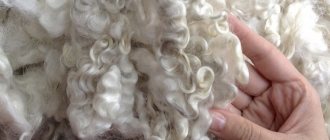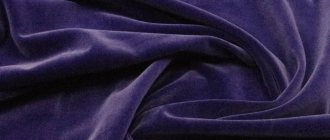What are grommets?
Eyelets are special fasteners that are fixed directly into the fabric. They are rings inserted into holes in the material. A cornice runs through them.
Eyelets are made from different materials:
- wood,
- plastics,
- metal
Eyelets can be round, but other geometries are also possible. The main thing is that it does not impede the movement of the canvas along the cornice.
How to sew curtains with eyelets yourself
For sewing you will need:
- piece of fabric;
- sewing machine;
- suitable ring diameter;
- grommet tape (adhesive);
- threads to match the fabric,
- sharp scissors,
- ruler, iron tape measure.
First, the sides and bottom of the curtain are processed with a hem seam, the top is decorated with curtain tape. The upper edge is folded 9-11 cm inward, a grommet tape is glued, ironed, and stitched across the top. Next we move on to installing the eyelets.
Fabric selection
The most important point when choosing curtain fabric is its basic properties, texture, density. You need to select textile material to suit the planned interior style, taking into account the purpose of the product. Typically, curtains are used for decoration, softening the window line, noise protection, light insulation, and room insulation. Synthetic fabrics usually have long-lasting colors, while natural fabrics quickly fade in the sun.
The names of the draperies here are very different:
- tapestry - a dense natural material that perfectly blocks street light;
- velvet – heavy, voluminous, good protection from cold and sun, made from natural or synthetic threads;
- brocade - created by interweaving bright threads with a “rich” texture, perfectly retains heat in the room;
- poplin - has a medium-density weave, a beautiful ribbed surface;
- satin - smooth, shiny, medium-density material;
- cotton is light, airy, allows you to “separate” the indoor space from the street, but only partially blocks the light;
- viscose - made from cellulose, shiny, slightly crunchy, drapes wonderfully;
- organza - usually created from mixed fibers, it is hung on a cornice together with a denser fabric;
- various types of tulle - linen or silk lace, slightly scattering light. This includes cobwebs, veils, etc.;
- jacquard - has a complex pattern, it is a durable, dense material with average light transmission;
- denim - cotton fabric with impurities, blocks light at a medium level;
- chenille is a fleecy jacquard with a rather textured appearance.
It is better to wet and iron any natural fabric first - this will avoid shrinkage.
Fabric calculation
The calculation of drapery requires the presence of folds, so the material is purchased twice as wide as the window opening. To find out the height of the cut, add 9-11 cm to the expected (finished) length of the curtain for the top hem, 1.5-2.5 for the bottom. You can choose any length of curtain: a very short one is suitable for a nursery or kitchen; for the living room and bedroom, elongated versions up to the floor are purchased. The width is calculated as follows: to obtain beautiful folds, the length of the suspension is multiplied by two or three; when using thin tulle, the multiplication factor is 1.4-1.7.
It is important to take into account the seam allowances: side seams - 13-16 cm, bottom edge - 5-7 cm, top edge depends on the width of the grommet tape, with the addition of at least another two to three cm. If soft, not too dense fabric is used, then the distance from From the top edge to the ring, the bare minimum is done. An approximate calculation is as follows: if the window width is 1.5 meters, the multiplication factor is 2.5, plus 15 cm for seams, it turns out that 390 cm of fabric is required to sew the curtains. When the amount of matter has been calculated, they begin to determine the number of grommet rings.
For products consisting of two halves, adjustment of the pattern is usually required - then textiles are purchased with a reserve.
Markings for eyelets
The number of rings on each curtain is made even so that the edges are turned towards the window. Eyelets are selected 1.3-1.9 cm larger than the diameter of the curtain rod. To calculate the quantity, the width of the curtain is measured and divided by eight - the minimum permissible number of rings is obtained. The average distance between them is from 14 to 23 cm. The weight of the curtain is also important - the heavier it is, the more rings you will need.
The parts are installed on neatly hemmed curtains with already finished edges. You can calculate the exact distance between the parts as follows: place the future curtain on a flat surface, and mark the locations of the outer eyelets with a pencil or chalk. Afterwards, the distance between the midpoints of the two side elements is measured, the resulting number is divided by the number of parts, and the appropriate markings are made.
Methods for installing rings
For proper installation of curtain rings, leave five to six cm from the edges and three to four from the top. It is important to correctly calculate the interval between the rings - it depends on the type of material and the size of the round parts themselves. You need to install the elements like this:
- a grommet tape is placed at the top edge and glued using an iron;
- bend and stitch the upper part;
- The location of the rings is marked on the fabric, starting from the edge;
- the very first eyelet is installed three to five cm from the edge - it is placed in the right place, and the inner circle is drawn with chalk;
- a hole is cut - for this, five mm are retreated from the markings;
- The part is applied on both sides of the fabric, aligned and snapped together. When elements are selected that do not snap into place, special tools are used - a flaring machine, a punch.
If it turns out that the grommet is placed crookedly, it is removed and carefully reinstalled. The same is done if a part comes off during washing.
Required tools for installation
Eyelets are most often installed manually, although many special devices have been invented for these purposes. The main tool here is a special “fabric puncher”, which is capable of making round holes, also known as a press, tongs and a clamp. Devices are sometimes sold in sets, since multifunctional ones are less convenient.
Devices for installing the described fittings are:
- manual - such as “cropodile”, collapsible hammers, tongs, punches, products such as “Mikron”, “Fiskars”, “Kangaro”, etc.;
- “semi-automatic” - have a fairly high productivity - up to 1200-1350 rivets per hour, depending on the model;
- “automatic machines” are large-sized machines used in mass production. In an hour they install tens of thousands of elements.
Most home craftswomen prefer to insert rings and their imitation using hand-held machines.
Advantages of eyelets
Fastening curtains with eyelets has many advantages:
- the curtains form a beautiful assembly, the folds are smooth from the ceiling to the floor surface,
- They are convenient to remove and easy to hang,
- the fabric does not stretch or deform at the attachment points,
- curtains move easily,
- The fastening is suitable for different types of fabrics.
Having assessed all the advantages of this type of fastening, it is logical to analyze their disadvantages.
- By using eyelets, it will no longer be possible to create a multi-layer composition.
- Very thin fabrics are not suitable for eyelets.
Photos of curtains with eyelets will help you weigh all the arguments and determine whether the grommets are suitable for a particular room.
Advantages of choice
1. Reliability.
Curtains hung on grommets are almost impossible to tear off even with a good tug or sharp pull. The cornice is more likely to not withstand the load than the fastening.
Curtains with eyelets are reliable and safe
2. Aesthetics.
The neat, even waves formed by the curtains look impressive in the interior design of any stylistic orientation. The fixtures themselves will also decorate the interior. Today, eyelets are offered in a wide variety of shades and shapes, which makes it easy to select them for decorating rooms of a wide variety of functionality and design. All that remains is to solve the question of how to install eyelets on curtains with your own hands.
Curtains with eyelets are suitable for any interior style
3. Durability.
Since the fasteners do not have sharp teeth that can deform the fabric and leave unsightly puffs on it, the curtains will last for decades.
Eyelets will extend the life of curtains
4. Easy to operate and maintain.
Curtains are equally easy to hang and remove. They do not lose their shape when washed. The reliability of the fasteners and the ease of their movement along the cornice will make it easy for even a child to curtain the window.
Curtains with grommets are easy to hang and remove
Types of curtains
Conventionally, three options for using eyelets can be distinguished.
Curtains
These are curtains made of thick fabric that does not allow light to pass through. Classic curtains made of thick fabrics look heavy and voluminous.
Attached to eyelets, they look less bulky and fall in beautiful folds.
Note!
- Curtains with lambrequin - choice of colors and tones. Features of types of lambrequins. Instructions for sewing lambrequins with your own hands (photo + video)
- Greek curtains: TOP 140 photos and video reviews. Choice of material and colors. Features of Greek curtains for different rooms. Installation nuances
Green curtains: features of choosing colors and shades of green. A combination of interior styles with green curtains. Photo and video reviews from designers
Mounting features
You can hang curtains with grommets only on a cornice of one type of structure - a pipe. However, there is also a joyful moment - recently in the assortment of many manufacturers you can find many different tips: simple and complex, carved or forged, geometric or with floral motifs.
Thanks to the use of similar decorative elements at the ends of curtain rods with eyelets, you can give any cornice an original appearance.
The design of tubular cornices for grommets is usually represented by one rod, although there are models where their number reaches two. The latter option is used in rooms with thick curtains and tulle. Curtains made of thick fabrics are attached to a tube with a large diameter, and for tulles a tube of a smaller cross-section is used.
You can solve the problem of creating a certain style using curtains with eyelets if they are successfully combined with other types of textiles. Such an addition to it can be roller or Roman blinds. In this case, the grommet curtain will acquire the effect of lightness and airiness; the amount of sunlight entering the room will be regulated by a roller blind, which will be fixed directly to the window frame.
Using similar combinations of decor of different styles allows you to give the interior a more modern touch without losing its functionality. It is noteworthy that curtains attached to a tubular cornice can serve not only as decoration for a window, but also as an element for zoning space.
Curtains, which attract attention with their pronounced decorativeness and the ability to naturally move along the pipe, can be used as a false wall or screen. Such a fairly simple technique can be used in large rooms, when you want to mark the boundary between the guest area and the bedroom
Caring for grommet curtains
Buying high-quality curtains with eyelets guarantees that they will be very easy to care for. These curtains can be washed by hand or in a washing machine, provided that the washing cycle is set to a delicate cycle. They must be placed in a special mesh bag designed for washing delicate items.
Then you can protect the eyelets from the mechanical effects of the machine drum, and this gives you confidence that nothing will happen to the curtain fabric either. However, I would like to repeat once again that it is enough to follow the rules for washing high-quality curtains so that they serve you for many years.
But if it so happened that you came across not very high-quality eyelets and after the first wash you saw damage or they caused damage to the fabric that “crept,” then you can replace any ring with your own hands. To do this, just go to any textile and accessories store and pick up a suitable spare ring there.
Kiseya
Universal curtains are used not only for window decoration, but also for dividing rooms and decorating doorways.
This type of curtains is difficult to confuse with others due to their original appearance. Kiseya is a bit like noodles. Beads or tiebacks are used for decoration.
Metal eyelets
Metal elements are durable, but when the coating is abraded, they can become covered with a layer of rust. For this reason, it is recommended to remove them before washing and carefully inspect them periodically.
If the surface coating has worn off, the element can be coated with colorless varnish. This will help avoid rust stains on the curtain fabric.
Note!
- Fashionable curtains: TOP-170 photos and video reviews of fashionable curtains. Selection of curtains for different rooms and styles. Fabric and color options
- Beige curtains: features of beige shades, rules for color combinations. Choosing an interior style for beige curtains. Types of fabric materials (photo + video)
- Brown curtains: varieties of curtains and curtains. Tips on choosing materials, colors, patterns and sizes of curtains. Brown curtains for different styles (photo + video)
Materials for curtains with eyelets
Ready-made curtains with eyelets are made from different materials.
- Curtains made of a special dense material called blackout, produced using a special technology, have excellent performance characteristics. They are durable, resistant to damage and deformation, and do not transmit light.
- Linen curtains have an original texture, are safe for health, durable and do not absorb dust.
- Jacquard curtains have an original pattern, are practical and perfectly complement the interior.
- Silk curtains are popular because of their beautiful appearance.
- Velvet curtains are appropriate for classic interiors and large rooms.
- The matting does not wrinkle, looks practical and fits perfectly into a country or Scandinavian style interior.
- Tulle also looks unusual on eyelets.
Note!
- Turquoise curtains: advantages and disadvantages of turquoise colors. Rules for combining turquoise curtains with interior elements. Selection of fabric materials (photo + video)
- Olive curtains: advantages and disadvantages of olive color for curtains. A range of combinations and varieties of shades. Types of olive curtain designs (photo + video)
- Curtains for a small kitchen: TOP-140 photos and videos of curtain options for a small kitchen. Tips for choosing length, number of layers, fabric and colors
Types of eyelets for curtains.
Depending on the material from which they are made, eyelets can be: plastic, metal, or wood. Based on size, there are small (1.5-3 centimeters in diameter) and large (up to 6 centimeters). This division is not just a convention. The purpose, fabric calculation and installation method can vary greatly.
The shape of the eyelets can be round, square, triangular, or complex in shape (snowflake, for example). It’s impossible to list all the shapes, but round eyelets make up the vast majority. It is impossible to say briefly about the color and texture of the eyelets. Smooth, grooved, nickel-plated, translucent, all shades of the rainbow. Expanse for the designer. We decide only one thing right away - the eyelet should merge with the fabric or sharply contrast with it. Read more about this in the “Room Design” section. Choice of fabric." When choosing eyelets, pay attention to the packaging method and the absence of scratches and damage. Their cost, including installation work, is comparable to the cost of fabric, and it will not be pleasant if some of the products are damaged.
Curtains with eyelets in the interior
The original fastening of curtains can be used in rooms for various purposes.
Curtains with eyelets with tulle are appropriate for decorating a living room. Especially if the room is located on the north side. It is recommended to match the eyelets to the tone of the cornice or fabric.
For the bedroom you should choose linen curtains. Preferably a neutral color or a pop art design.
In the kitchen, curtains with eyelets will help create a special atmosphere of home comfort and emphasize the style of decoration.
The nursery itself involves various unusual decor options. Therefore, eyelets are appropriate here too.
The idea of originally attaching curtains using eyelets is a very original option for decorating a room. You can buy ready-made curtains or sew them yourself.
To develop a preliminary sketch, it’s a good idea to look at the curtains on the eyelets, photos of new items in manufacturers’ catalogs.
Curtain sewing technology
Making a curtain begins with processing the top and gluing the tape. A master class with step-by-step instructions given below will tell you how to sew curtains with eyelets:
- Fold it over to the wrong side and carefully iron 2 cm of the top edge of the future product. If the craftswoman does not have much experience, it is best to first draw a straight line along which the fold will go.
- Measure the height of the comb from the smoothed rib. Draw a straight line and iron it inside out again. The cut of the top will be inside, between the layers of fabric.
- Unfold the ironed edge and insert tape with an adhesive layer (grommet) inside. As mentioned above, its width should coincide with the height of the comb - the width of the pressed hem. On thin fabrics, it is advisable to shorten it in relation to the fabric by the amount of allowances for processing the side edges.
- Heat the iron high and iron the folded part of the panel so that the tape inside sticks well. Be sure to perform this step through gauze or a clean white cotton cloth. When ironing thin tulle, you can pre-moisten the gauze.
- On the wrong side, stitch the hem 2-3 mm from the edge, securing it. At the same time, you can sew on decorative braid if the design solution requires it.
- Fold and stitch the side seams.
You may also be interested in: Austrian curtains - design, appearance
After the panel is ready, sewing curtains on eyelets involves installing rings. But how to make the eyelets neat, like in the pictures? To do this, you will need the results of calculating the distance between the centers of the rings, a ruler and chalk.
Installation of eyelets
Set aside 1.2-1.5 cm from the side edge. If the calculations were made correctly, the mark will have to be placed a little further than the line. From this mark, set aside ½ of the outer dimension of the ring and mark the center of the outer insert. Do the same on the other side of the tape.
Set aside from the center mark an amount equal to the distance between the eyelets. Place a dot to mark the center of the next ring. Set aside the same segment again, mark and continue until the end of the tape. If everything was calculated without errors, the last mark should match exactly the next time you measure the distance between the eyelets.
If the error and discrepancy are too large, an error in the calculations is likely. You need to measure the distance between the extreme center marks and recalculate the size of the fold, dividing the distance by the number of eyelets. After this, repeat the markings.
Place the outer ring on the comb so that the mark is in the center of the inner hole. Trace a circle inside. Do this for each mark.
Use nail scissors to carefully cut holes for the rings. The eyelets themselves are installed very simply: the lower half is placed under the fabric (from the inside out). The edges of the hole should fit around the bushing. The upper, decorative part is placed on top and pressed until it clicks.
How to hem the bottom of a product?
To make your new curtains look beautiful, you need to know how to properly sew and trim the bottom edge. The almost finished product needs to be hung on the cornice rod. Determine at what distance from the floor the bottom of the curtain should be. This value must be measured from its surface several times, along the entire fabric, placing marks on the fabric.
Remove the curtain and lay it flat. Connect the marks using a ruler. The straight line will be the bottom line. Fold the material inside out along it and iron the fold. From the fold, set aside the desired width of the hem, draw a line, bend the cut along it inward and iron. Stitch 2-3 mm from this last fold.
If you carefully carry out all the operations one by one, then neither inserting eyelets for curtains nor processing the edges of a large product will seem difficult. In this case, the accuracy of measurements for the uniform arrangement of the rings and the accuracy of processing the cuts are important.
Curtains with eyelets yourself
Making curtains with eyelets yourself is not as difficult as it might seem at first glance.
To work you will need:
- fabric for curtains,
- eyelets,
- special adhesive tape,
- scissors,
- sewing machine,
- threads,
- meter tape.
Detailed instructions will tell you how to sew curtains with eyelets.
- For beautiful folds, the width of the canvas should be twice as large as the size of the window.
- You need to add 10 cm to the top bend, 2-3 cm to the bottom.
- Each curtain must have an even number of eyelets. Their diameter is chosen to be 1.5 cm larger than the cornice.
- The fabric is folded and all edges are machine stitched.
- The top edge from the inside is duplicated with adhesive tape, the distance between the fasteners is calculated and marked.
- The holes are cut to the diameter of the eyelets, they are inserted and secured.
The work is done. It is noteworthy that the eyelets are perfect for popular curtain rods and such fastening does not require additional costs for their replacement.
A modern option for attaching curtains using eyelets will help make the interior original and will become a real highlight of any room.
Calculation of curtain width
Curtains with eyelets differ from standard window curtains not only in their expensive appearance. When sewing such a product, much more material is spent than when making a regular curtain. Therefore, it is impossible to do without careful preliminary calculations.
In which room do eyelet curtains look most appropriate?
In the living room In the bedroom (including the children’s room) In the kitchen It doesn’t matter, but provided that the room is large None, I don’t like them in principle
And to sew such window drapery yourself, you need:
- measure the width of the window(s);
- measure the distance between the cornice (topmost edge) and the lowest point of the future curtain (b). If it is long, then the floor acts as the lowest point;
- to the resulting height (b) add the lower (4-10 cm) and upper (8-10 cm) allowances. The height of the top allowance is directly dependent on the size of the grommet tape, which is sewn at the top on the wrong side of the curtain. Its standard height is 8-10 cm:
b + 4 + 8;
- add side allowances (1.5-2 cm) to the desired width (a):
a + (2 x 2).
The figures obtained as a result of the calculation will indicate how much material will be needed to make a specific curtain with eyelets.
Calculation of fabric for sewing curtains with eyelets:
